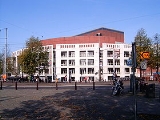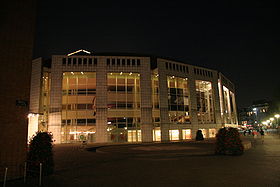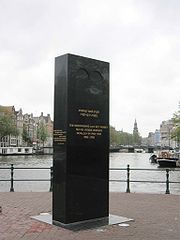
Stopera
Encyclopedia

Amsterdam
Amsterdam is the largest city and the capital of the Netherlands. The current position of Amsterdam as capital city of the Kingdom of the Netherlands is governed by the constitution of August 24, 1815 and its successors. Amsterdam has a population of 783,364 within city limits, an urban population...
, The Netherlands, housing both the city hall of Amsterdam and the Muziektheater, the principal opera house
Opera house
An opera house is a theatre building used for opera performances that consists of a stage, an orchestra pit, audience seating, and backstage facilities for costumes and set building...
in Amsterdam and the home of De Nederlandse Opera
De Nederlandse Opera
De Nederlandse Opera , in Amsterdam, is a Dutch opera company based in Amsterdam, Netherlands. Its present home base is the Het Muziektheater, a modern building designed by Cees Dam which opened in 1986....
, Het Nationale Ballet, and the Holland Symfonia
Holland Symfonia
The Holland Symfonia is a Dutch symphony orchestra, based in Haarlem, The Netherlands. The term "Symfonia" derives from an amalgam of the Dutch word symfonie and the Italian word sinfonia...
.
The name "Stopera" is a portmanteau of stadhuis (Dutch: "city hall
City hall
In local government, a city hall, town hall or a municipal building or civic centre, is the chief administrative building of a city...
") and opera.
The Stopera is located in the center of Amsterdam, between Waterlooplein
Waterlooplein
Waterlooplein is a square in the centre of Amsterdam, The Netherlands, near the Amstel river. The daily flea market on the square is popular with tourists. The Stopera city hall and opera building and the Mozes en Aäronkerk church are at Waterlooplein....
square, the Amstel
Amstel
The Amstel is a river in the Netherlands which runs through the city of Amsterdam. The river's name is derived from Aeme stelle, old Dutch for "area abounding with water"....
river and the Zwanenburgwal
Zwanenburgwal
The Zwanenburgwal is a canal and street in the center of Amsterdam. The painter Rembrandt and philosopher Spinoza lived here. In 2006 it was voted one of the most beautiful streets in Amsterdam by readers of Het Parool, a local daily newspaper....
canal, on a piece of land called Vlooienburg which was reclaimed in the 16th century. The building is located on a bend of the river Amstel
Amstel
The Amstel is a river in the Netherlands which runs through the city of Amsterdam. The river's name is derived from Aeme stelle, old Dutch for "area abounding with water"....
. The opera house building is shaped like a huge, massive block, with a curved front facing the city. Its glass facade provides panoramic views of the river from the curved interior foyers.
Next to the Stopera is the Joods Verzetsmonument, a 1988 monument to the Jewish victims of World War II
World War II
World War II, or the Second World War , was a global conflict lasting from 1939 to 1945, involving most of the world's nations—including all of the great powers—eventually forming two opposing military alliances: the Allies and the Axis...
. A remembrance of the Kristallnacht
Kristallnacht
Kristallnacht, also referred to as the Night of Broken Glass, and also Reichskristallnacht, Pogromnacht, and Novemberpogrome, was a pogrom or series of attacks against Jews throughout Nazi Germany and parts of Austria on 9–10 November 1938.Jewish homes were ransacked, as were shops, towns and...
is held at the monument every year.
History

After a number of ups and downs lasting over 10 years, from a 1955 commission to come up with a proposal to the architectural firm of Berghoef and Vegter to a rejection of them in 1964, the city council finally held a competition in 1967 for a new design. Viennese architect Wilhelm Holzbauer emerged as the winner. However, plans for the new city hall were put on hold for several years. Similarly, the opera house plans were in flux.
In 1979, the architect proposed that the city hall and opera house should be combined into one complex, so that the Dutch National Ballet (Het Nationale Ballet), alongside the Netherlands Opera, would have a combined performance space.
Architect Cees Dam took over in 1980 when the Amsterdam city council approved the new design, which was followed by full national approval in 1981.
The Stopera was a controversial project that met with heavy protests, particularly from local counterculture and leftwing groups like the squatter movement and Provo movement. Riots broke out when construction began in 1982. The project went seriously over budget and ended up costing an additional 112 million guilder
Guilder
Guilder is the English translation of the Dutch gulden — from Old Dutch for 'golden'. The guilder originated as a gold coin but has been a common name for a silver or base metal coin for some centuries...
s more than originally budgeted.
The Muziektheater officially opened on September 23, 1986; the new city hall opened two years later.

